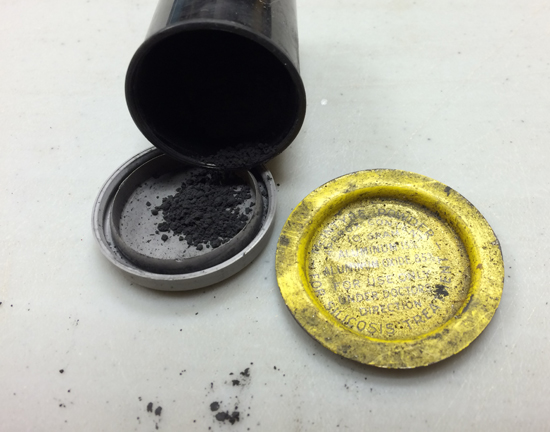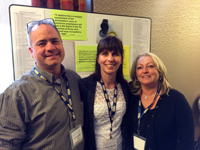
Supported by her union, the United Steelworkers (USW), and other worker advocacy organisations, Janice Martell waged a relentless campaign to compel Ontario’s Workplace Safety and Insurance Board (WSIB) to recognise Parkinson’s as an occupational disease linked to the use of McIntyre Powder in mining and other industries.
The powder was an aluminium-based inhalant used until 1979 in many mines and other industries where workers might be exposed to silica dust. Tin miners in Cornwall used the powder up to the mid-1960s, and studies were conducted on UK coal miners and pottery workers in the 1950s. The theory, which was disproved in the UK and in other studies, was that inhaling the powder would protect workers’ lungs. Instead, it made workers sick, and led to many deaths.
Martell’s father, Jim Hobbs, developed Parkinson’s after being subjected to the non-consensual McIntyre Powder treatments while working at a uranium mine in Elliot Lake, Ontario. He was diagnosed a decade after leaving the industry in 1990 and died aged 76 on 24 May 2017. Concerns about the cause of her father’s illness prompted Martell to create the McIntyre Powder Project.
The campaign led by Martell, the USW and the Occupational Health Clinics for Ontario Workers (OHCOW), resulted in the authorities in August 2017 commissioning “the largest ever study on the topic” by the Occupational Cancer Research Centre (OCRC). In February 2022, the WSIB revealed the study “showed a statistically significant increased risk of Parkinson’s disease in McIntyre Powder-exposed miners compared to miners with no McIntyre Powder exposure.”
"Nobody did a study until the OCRC did, and that's because I was finding high rates of Parkinson's as a lay person, just asking the question,” Martell said.
It prompted Ontario’s labour minister Monte McNaughton to announce the provincial government would recognise McIntyre Powder-related compensation claims from former workers and surviving family members. A WSIB statement noted: “Parkinson’s disease has been added as a new occupational disease… effective January 27, 2022.
“This means that if anyone was exposed to McIntyre Powder through work in the mining industry and develops Parkinson’s disease, the disease is presumed to be work-related, unless the contrary is shown.”
Martell said: “Now, other workers who are struggling with occupational disease, and the families of workers who have died, will be able to pursue the compensation they deserve, and find some measure of justice.” She told Hazards: “When I started the McIntyre Powder Project and researched the history of this, it was so appalling and I had no idea how to reach those affected - only that I needed to try.”
|
DAD’S STORY “In 2011, I filed a claim for my dad for Parkinson's related to McIntyre Powder exposure. He was an underground miner in Sudbury and Elliot Lake, and his exposure to McIntyre powder was in Elliot Lake at Rio Algom Quirke Mine,” said Martell. “He was there until the mine closed in 1990, and 10-11 years later, he was diagnosed with Parkinson's, having first showing symptoms in 2000. Ten years after that in 2011, is when I found out he had been exposed to McIntyre powder.”
|
BURIED EVIDENCE Martell delved into into the Archives of Ontario and uncovered damning but well hidden evidence. “I wrote a journal article on McIntyre Powder history, dad's story, and the McIntyre Powder Project. A second featured the lived experiences of the miners, not only with McIntyre Powder exposure, but also with workers’ compensation claims suppression.” She said the industry operated a “light duty” programme for workers too ill to continue in their normal jobs, so they didn’t feature in health and safety statistics.
|
JUSTICE DENIED Martell's compensation claim with WSIB on behalf of her father was denied, resubmitted and repeatedly denied again. “I realised that WSIB had this negative entitlement policy that automatically denied any claims for neurological issues related to occupational aluminium exposure. We wouldn't be able to win his claim, or even get answers about what the long-term health effects of McIntyre Powder were unless we went about it in a different way,” she said.
|
BIG QUESTION “The WSIB has outdated occupational disease policies,” Martell said. “They admitted they haven't reviewed occupational disease policies for years, sometimes decades. So they're not following the science. They're not tracking these workers. You're not going to have the science unless you're looking at the workers. In 2021, Martell was in attendance as Jim Hobbs’ name was added to the Elliot Lake Miners’ Monument.
|
DISEASE REGISTERED In April 2015, Martell started a volunteer registry to determine how many former miners had health issues, and how these might related to McIntyre Powder exposure. There are now well over 500 individuals on the list. Over 50 have developed Parkinson's Disease. Martell (centre) teamed up with JP Mrochek of the USW Local 6500 and Sylvia Boyce, the health and safety coordinator with USW District 6, to organise occupational disease advice and mapping clinics.
|
FINE LINE “One of the aspects of McIntyre Powder that may have links beyond aluminium is the fact that McIntyre Powder was so finely ground that it falls in the fine and ultrafine - nanoparticles - size of particulates,” Martell told Hazards. “So I think some of the findings that are going to come regarding McIntyre Powder would have implications for workers exposed to fine and ultrafine particulates as well - for example, cardiovascular disease.
POISONED BREATH
A decade-long campaign led by the daughter of a deceased Canadian uranium miner has led to a major victory for workers struck by Parkinson’s disease after being subjected to aluminium dust inhalation “treatments” in their jobs.
Further information
McIntyre Powder Project
www.mcintyrepowderproject.com
Janice Martell and Tee Guidotti. Breathe Deep, Boys: Voices of the McIntyre Powder Project Miners, New Solutions: A Journal of Environmental and Occupational Health Policy, 9 February 2022.
Janice Martell and Tee Guidotti. Trading one risk for another: Consequences of the unauthenticated treatment and prevention of silicosis in ontario miners in the McIntyre Powder aluminum inhalation program, New Solutions: A Journal of Environmental and Occupational Health Policy, 8 August 2021.
MCS Kennedy. Aluminium Powder Inhalations in the Treatment of Silicosis of Pottery Workers and Pneumoconiosis of Coal-Miners, British Journal of Industrial Medicine, volume 13, Number 2, pages 85-101, April 1956.
Investigation of McIntyre Powder Exposure and Neurological Outcomes in the Mining Master File Cohort: Final Report, Cancer Research Centre (OCRC), 12 March 2020.
Images
Click on images for larger versions












